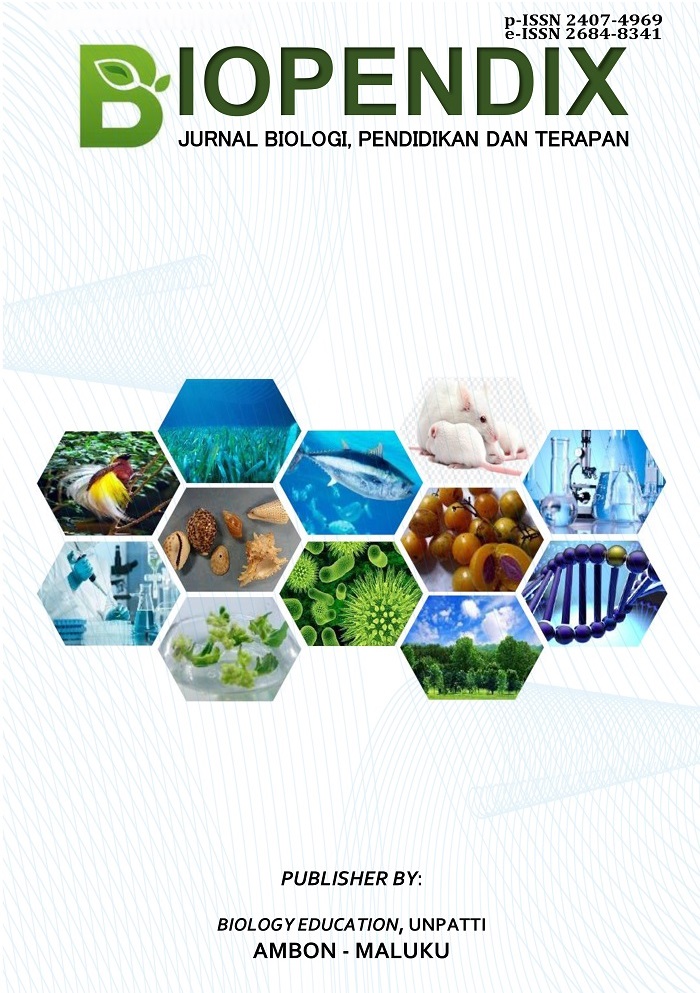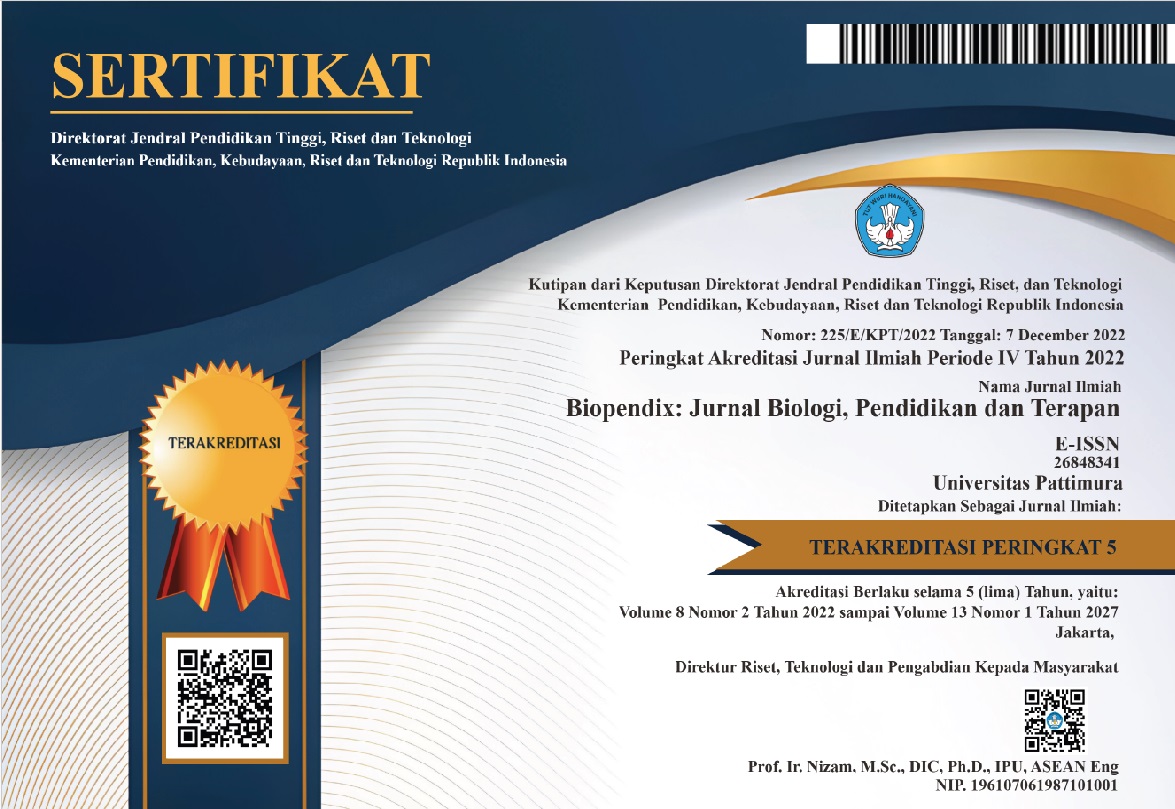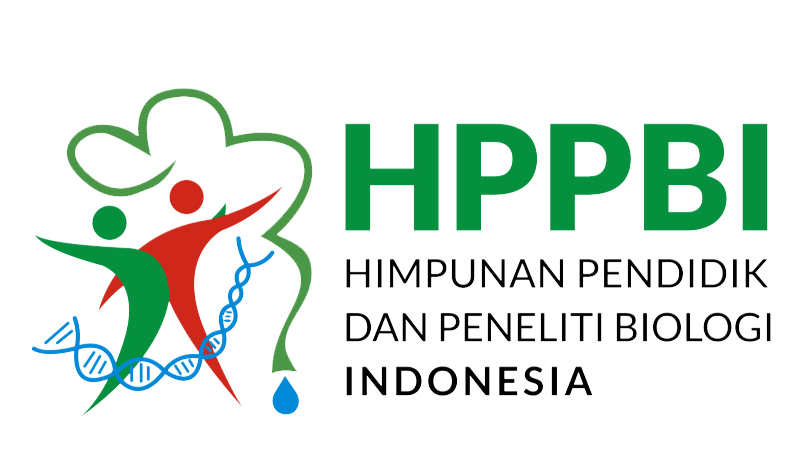Wolbachia Pipientis as a Natural Biocontrol Agent to Inhibit Dengue Virus Replication in Aedes Aegypti Mosquitoes
Abstract
Wolbachia pipientis is an endosymbiotic bacterium commonly found in insects, arthropods, and certain nematodes, playing a pivotal role in host reproductive manipulation and pathogen resistance enhancement. This review aims to provide a comprehensive understanding of the characteristics, physiology, and ecological roles of Wolbachia pipientis, as well as its potential in vector control strategies to combat insect-borne diseases. A literature-based approach was employed, utilizing peer-reviewed scientific journals from reputable sources such as Scopus and Web of Science. The analysis revealed that Wolbachia pipientis is a Gram-negative bacterium with a small size (0.2 to 0.5 µm) that reproduces through binary fission within host cells and relies on the host for essential nutrients. It modulates host gene expression and enhances host immunity, thereby reducing the transmission of pathogens like dengue, Zika, and chikungunya through cytoplasmic incompatibility. Furthermore, Wolbachia pipientis has shown potential in managing filariasis by inhibiting nematode reproduction. The bacterium's ability to alter host reproductive dynamics through mechanisms like feminization and parthenogenesis makes it an effective tool in biocontrol programs. The findings underscore the importance of Wolbachia pipientis in improving public health and environmental sustainability by controlling disease vectors and supporting ecological balance. This review highlights the need for further research to explore genetic engineering approaches to enhance the effectiveness of Wolbachia pipientis in global health management.
Downloads
References
Baldo, L., Hotopp, J. C. D., Jolley, K. A., Bordenstein, S. R., Biber, S. A., Choudhury, R. R., Hayashi, C., Maiden, M. C. J., Tettelin, H., & Werren, J. H. (2006). Multilocus sequence typing system for the endosymbiont Wolbachia pipientis. Applied and Environmental Microbiology, 72(11), 7098–7110. https://doi.org/10.1128/AEM.00731-06
Bian, G., Xu, Y., Lu, P., Xie, Y., & Xi, Z. (2010). The endosymbiotic bacterium Wolbachia induces resistance to dengue virus in Aedes aegypti. PLoS Pathogens, 6(4), 1- 10. https://doi.org/10.1371/journal.ppat.1000833
Bourtzis, K., Dobson, S. L., Xi, Z., Rasgon, J. L., Calvitti, M., Moreira, L. A., Bossin, H. C., Moretti, R., Baton, L. A., Hughes, G. L., Mavingui, P., & Gilles, J. R. L. (2014). Harnessing mosquito-Wolbachia symbiosis for vector and disease control. Acta Tropica, 132(1), 150 - 163. https://doi.org/10.1016/j.actatropica.2013.11.004
Dunning Hotopp, J. C., Clark, M. E., Oliveira, D. C. S. G., Foster, J. M., Fischer, P., Muñoz Torres, M. C., Giebel, J. D., Kumar, N., Ishmael, N., Wang, S., Ingram, J., Nene, R. V., Shepard, J., Tomkins, J., Richards, S., Spiro, D. J., Ghedin, E., Slatko, B. E., Tettelin, H., & Werren, J. H. (2007). Widespread lateral gene transfer from intracellular bacteria to multicellular eukaryotes. Science, 317(5845), 1753–1756. https://doi.org/10.1126/science.1142490
Dutra, H. L. C., Rocha, M. N., Dias, F. B. S., Mansur, S. B., Caragata, E. P., & Moreira, L. A. (2016). Wolbachia Blocks Currently Circulating Zika Virus Isolates in Brazilian Aedes aegypti Mosquitoes. Cell Host and Microbe, 19(6), 771–774. https://doi.org/10.1016/j.chom.2016.04.021
Foster, J., Ganatra, M., Kamal, I., Ware, J., Makarova, K., Ivanova, N., Bhattacharyya, A., Kapatral, V., Kumar, S., Posfai, J., Vincze, T., Ingram, J., Moran, L., Lapidus, A., Omelchenko, M., Kyrpides, N., Ghedin, E., Wang, S., Goltsman, E., … Slatko, B. (2005). The Wolbachia genome of Brugia malayi: Endosymbiont evolution within a human pathogenic nematode. PLoS Biology, 3(4), 0599 - 0614. https://doi.org/10.1371/journal.pbio.0030121
Hedges, L. M., Brownlie, J. C., Neill, S. L. O., & Johnson, K. N. (n.d.). Wolbachia and Virus Protection in Insects. 6.
Hoffmann, A. A., Montgomery, B. L., Popovici, J., Iturbe-Ormaetxe, I., Johnson, P. H., Muzzi, F., Greenfield, M., Durkan, M., Leong, Y. S., Dong, Y., Cook, H., Axford, J., Callahan, A. G., Kenny, N., Omodei, C., McGraw, E. A., Ryan, P. A., Ritchie, S. A., Turelli, M., & O’Neill, S. L. (2011). Successful establishment of Wolbachia in Aedes populations to suppress dengue transmission. Nature, 476(7361), 454–459. https://doi.org/10.1038/nature10356
Ioannidis, P., Johnston, K. L., Riley, D. R., Kumar, N., White, J. R., Olarte, K. T., Ott, S., Tallon, L. J., Foster, J. M., Taylor, M. J., & Dunning Hotopp, J. C. (2013). Extensively duplicated and transcriptionally active recent lateral gene transfer from a bacterial Wolbachia endosymbiont to its host filarial nematode Brugia malayi. BMC Genomics, 14(1), 20–30. https://doi.org/10.1186/1471-2164-14-639
Kaur, R., Shropshire, J. D., Cross, K. L., Leigh, B., Mansueto, A. J., Stewart, V., Bordenstein, S. R., & Bordenstein, S. R. (2021). Living in the endosymbiotic world of Wolbachia: A centennial review. Cell Host and Microbe, 29(6), 879–893. https://doi.org/10.1016/j.chom.2021.03.006
LePage, D., & Bordenstein, S. (2008). Wolbachia: can we save lives with a great pandemic? Daniel. Bone, 23(1), 1–7. https://doi.org/10.1016/j.pt.2013.06.003.
Newton, I. L. G., & Rice, D. W. (2020). The Jekyll and Hyde symbiont: Could Wolbachia be a nutritional mutualist? Journal of Bacteriology, 202(4). https://doi.org/10.1128/JB.00589-19
Russell, J. E., & Stouthamer, R. (2011). The genetics and evolution of obligate reproductive parasitism in Trichogramma pretiosum infected with parthenogenesis-inducing Wolbachia. Heredity, 106(1), 58–67. https://doi.org/10.1038/hdy.2010.48
Serbus, L. R., Casper-Lindley, C., Landmann, F., & Sullivan, W. (2008). The genetics and cell biology of Wolbachia-host interactions. Annual Review of Genetics, 42, 683 - 707. https://doi.org/10.1146/annurev.genet.41.110306.130354
Taylor, M. J., Bandi, C., & Hoerauf, A. (2005). Wolbachia bacterial endosymbionts of filarial nematodes. Advances in Parasitology, 60(December), 245–284. https://doi.org/10.1016/S0065-308X(05)60004-8
Teixeira, L., Ferreira, Á., & Ashburner, M. (2008). The bacterial symbiont Wolbachia induces resistance to RNA viral infections in Drosophila melanogaster. PLoS Biology, 6(12), 2753–2763. https://doi.org/10.1371/journal.pbio.1000002
Werren, J. H., Baldo, L., & Clark, M. E. (2008). Wolbachia: Master manipulators of invertebrate biology. Nature Reviews Microbiology, 6(10), 741–751. https://doi.org/10.1038/nrmicro1969
Zhang, D., Lees, R. S., Xi, Z., Gilles, J. R. L., & Bourtzis, K. (2015). Combining the sterile insect technique with Wolbachia-based approaches: II - A safer approach to Aedes albopictus population suppression programmes, designed to minimize the consequences of inadvertent female release. PLoS ONE, 10(8), 1–14. https://doi.org/10.1371/journal.pone.0135194
Zug, R., & Hammerstein, P. (2012). Still a host of hosts for Wolbachia: Analysis of recent data suggests that 40% of terrestrial arthropod species are infected. PLoS ONE, 7(6), 7 - 9. https://doi.org/10.1371/journal.pone.0038544
Copyright (c) 2025 A Aida Ariya, Rahmawati, Yusminah Hala

This work is licensed under a Creative Commons Attribution-ShareAlike 4.0 International License.
Authors who publish with BIOPENDIX: Jurnal Biologi, Pendidikan dan Terapan agree to the following terms:
- Authors retain copyright and grant the journal right of first publication with the work simultaneously licensed under Creative Commons Atribution-ShareAlike 4.0 International License (CC BY-SA 4.0) that allows others to share the work with an acknowledgment of the work's authorship and initial publication in this journal.
- Authors are able to enter into separate, additional contractual arrangements for the non-exclusive distribution of the journal's published version of the work (e.g., post it to an institutional repository or publish it in a book), with an acknowledgment of its initial publication in this journal.
- Authors are permitted and encouraged to post their work online (e.g., in institutional repositories or on their website) prior to and during the submission process, as it can lead to productive exchanges, as well as earlier and greater citation of published work.





 2
2






